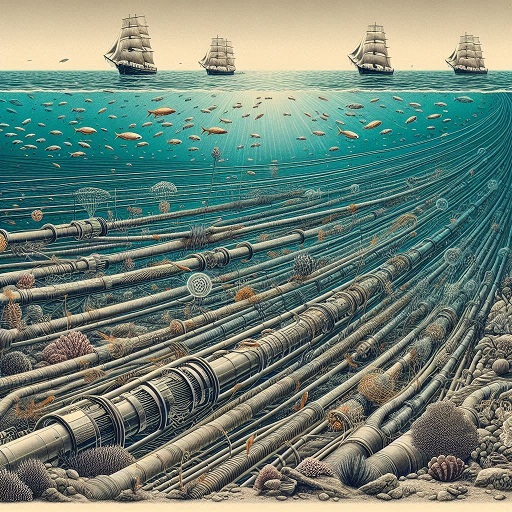Submarine cable systems have been the backbone of global communication for over a century. As the demand for high-speed internet and global connectivity grows, these systems continue to evolve, playing an increasingly crucial role in ensuring seamless data transmission across continents. The Future of Submarine Cable Systems promises advancements in technology, infrastructure, and strategic importance that will shape how the world stays connected.

The history of submarine cable systems dates back to the mid-19th century, with the first successful transatlantic cable laid in 1858. This milestone marked the beginning of a new era in global communication. Over the decades, technology has evolved from early copper-based cables to modern fiber optic cables capable of transmitting vast amounts of data at incredible speeds. Each new generation of submarine cables has built upon the successes and failures of its predecessors, driving innovation forward.
Stay ahead of the competition— Download PDF Brochure and make informed decisions to power your business growth!
Types of Submarine Cables
There are primarily two types of submarine cables used today:
- Fiber Optic Cables: These cables are the most common type and use light to transmit data. They are favored for their high bandwidth capabilities and low latency.
- Coaxial and Copper Cables: Though largely outdated, some copper cables are still in use for specific applications, though they are increasingly being replaced by fiber optics.
Technological Advancements
Advancements in optical amplifiers and repeaters have allowed submarine cables to span greater distances without signal degradation. These innovations, along with the development of stronger and more durable cable materials, have significantly enhanced the longevity and efficiency of undersea networks. New cable materials, such as improved protective layers, ensure greater resilience against environmental factors and physical stressors.
Installation and Maintenance
Submarine cable installation is a complex process that involves careful planning, sophisticated technology, and skilled labor. Installation techniques have improved significantly, allowing cables to be laid at greater depths and in more challenging environments. However, maintenance remains a challenge due to the remote and often harsh environments where these cables are located. Repair and maintenance strategies are evolving, with the introduction of automated systems for detecting faults and carrying out repairs.
Economic Impact
The economic impact of submarine cable systems is vast. They enable the global economy to function by supporting international trade, finance, and communication. The cost of laying and maintaining these cables is significant, but the return on investment is enormous, as they are critical to industries ranging from finance to entertainment.
Environmental Considerations
Laying submarine cables does have an impact on marine ecosystems, particularly in terms of disrupting seabed habitats. However, the industry has made strides in mitigating environmental risks by adopting environmentally friendly practices and ensuring that the impact on marine life is minimized.
Challenges in Submarine Cable Systems
The future of submarine cable systems is not without challenges. Geopolitical issues can affect where cables are laid and who controls them. Additionally, physical and technical challenges, such as undersea earthquakes and the immense distances involved, continue to pose risks to the integrity of these networks.
Future Trends in Submarine Cable Systems
Looking ahead, we can expect significant technological advancements in submarine cable systems. These include the development of faster, more efficient cables capable of handling the growing demands of the internet and global data transmission. Emerging markets, particularly in Africa and Southeast Asia, are likely to drive further expansion and investment in submarine cable infrastructure.
The global submarine cable system market size to grow from USD 18.2 billion in 2024 and is expected to reach USD 29.7 billion by 2029, growing at a CAGR of 10.3% from 2024 to 2029.
Submarine Cable Systems and Data Centers
Submarine cables are essential to the functioning of global data centers, which rely on high-speed connections to store and transmit vast amounts of data. As cloud computing and edge computing become more prevalent, the demand for robust, reliable submarine cable systems will only increase.
Security Concerns
As critical infrastructure, submarine cables are a target for cybersecurity threats. Nations and corporations are investing heavily in safeguarding these vital networks to protect against espionage, sabotage, and other malicious activities.
Global Competition
The race to control submarine cable routes is heating up, with global stakeholders vying for influence. Key players, such as the United States, China, and European nations, are competing for dominance in this strategic domain.
Impact of AI and Automation
AI and automation are transforming submarine cable systems by streamlining cable management and enhancing efficiency. These technologies are also being used to automate repairs and maintenance, reducing downtime and improving the overall resilience of these networks.
The future of submarine cable systems is bright, with continued advancements in technology, installation, and maintenance. As the world becomes more interconnected, these systems will remain at the heart of global communication infrastructure. The challenges are significant, but the opportunities are even greater.
FAQs
- What are submarine cable systems?
- Submarine cable systems are long-distance cables laid on the ocean floor that transmit data across continents.
- Why are submarine cables important?
- They are critical for global communication, supporting the internet, international trade, and financial systems.
- How are submarine cables installed?
- Installation involves complex planning, advanced technology, and specialized ships to lay cables on the seabed.
- What challenges do submarine cables face?
- They face physical challenges such as deep-sea pressure and technical challenges like cybersecurity threats.
- What role does AI play in submarine cable systems?
- AI helps automate cable management and maintenance, reducing costs and downtime.
- What is the future of submarine cable systems?
- The future looks promising with advancements in cable technology, increased global connectivity, and expansion into emerging markets.
